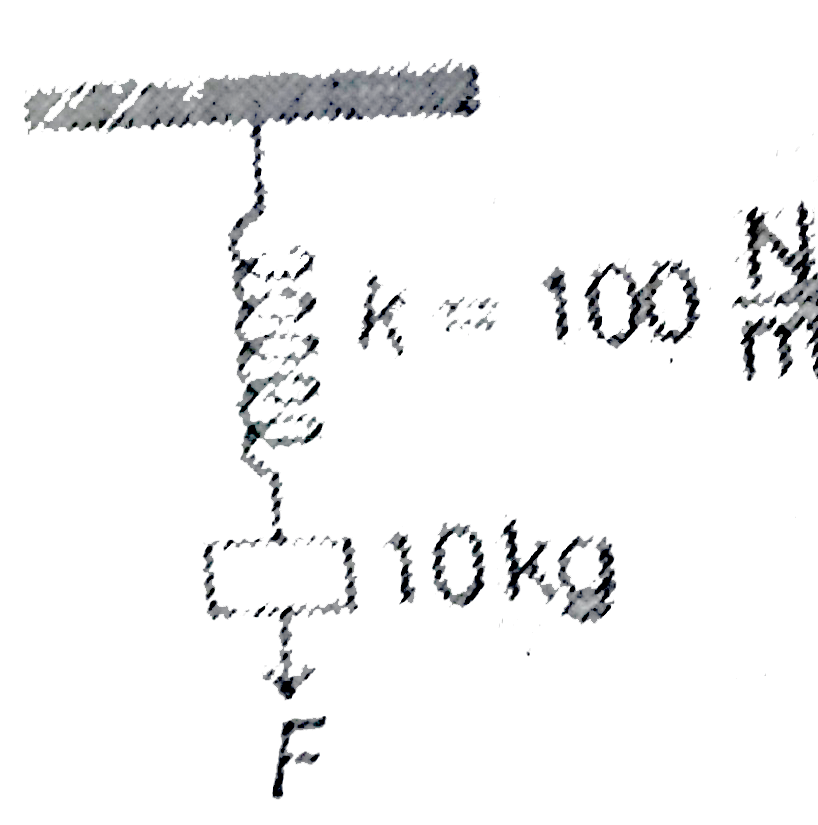Certain force acting on a 20 kg mass changes its velocity from 5m/s→2m/s. calculate the work done by the force.
The correct Answer is:210 J
To solve the problem of calculating the work done by the force acting on a 20 kg mass that changes its velocity from 5 m/s to 2 m/s, we can follow these steps:
Step 1: Identify the given values
- Mass (m) = 20 kg
- Initial velocity (u) = 5 m/s
- Final velocity (v) = 2 m/s
Step 2: Calculate the initial kinetic energy (KE_initial)
The formula for kinetic energy is given by:
KE=12mv2
Using the initial velocity (u = 5 m/s):
KEinitial=12×20kg×(5m/s)2
KEinitial=12×20×25=250J
Step 3: Calculate the final kinetic energy (KE_final)
Using the final velocity (v = 2 m/s):
KEfinal=12×20kg×(2m/s)2
KEfinal=12×20×4=40J
Step 4: Calculate the work done by the force
The work done (W) by the force is the change in kinetic energy, which can be calculated as:
W=KEinitial−KEfinal
Substituting the values we calculated:
W=250J−40J=210J
Final Answer
The work done by the force is 210 Joules.
---
- Mass (m) = 20 kg
- Initial velocity (u) = 5 m/s
- Final velocity (v) = 2 m/s
The formula for kinetic energy is given by:
KE=12mv2
Using the initial velocity (u = 5 m/s):
KEinitial=12×20kg×(5m/s)2
KEinitial=12×20×25=250J
Using the final velocity (v = 2 m/s):
KEfinal=12×20kg×(2m/s)2
KEfinal=12×20×4=40J
The work done (W) by the force is the change in kinetic energy, which can be calculated as:
W=KEinitial−KEfinal
Substituting the values we calculated:
W=250J−40J=210J
The work done by the force is 210 Joules.
Topper's Solved these Questions
Similar Questions
Consider a variable force F=(3x+5)N acting on a body and if it is displaced from x=2m to x=4m, calculate the work done by this force.
View SolutionA force applied by an engine of a train of mass 2.05×106kg changes its velocity from 5 m/s to 25 m/s in 5 minutes. The power of the engine is
View Solution
Knowledge Check
A constant force acting on a body of mass of 5 kg change its speed from 5ms−1to10ms−1 in 10 s without changing the direction of motion. The force acting on the body is
A1.5NB2NC2.5ND5N
A constant force acts on object of mass 5 kg for a duration of 2s It increases the object's velocity from 3m/s to 7m/s Find the magnitude of the applied force. Now if the force were applied for a duration of 5s what would be the final velocity of object?
View SolutionA force of 10N is acting on a block of 20kg on horizontal surface with coefficient of friction μ=0.2. Calculate the work done by the force.
View SolutionA position dependent force F=7−2x+3x2 acts on a small body of mass 2 kg and displaced it from x=0 to x=5m. Calculate the work done in joule.
View SolutionA body of mass m is moving with a uniform velocity U. A force is applied on the body due to which its velocity increases from u to v: How much work is being done by the force ?
View SolutionA vertical spring of force cosntant 100N/m is attached with a hanging mass of 10 kg. Now an external force is applied on the mass so that the spring is stretched by additional 2m. The work done by the force F is (g=10m/s2)

View SolutionA position dependent force F acting on a particle and its force-position curve is shown in the figure. The work done by force from x=1 m to x=4 m is

View SolutionAn object of mass 100kg is accelerated uniformly from a velocity of 5m/s to 8m/s in 6s. Calculate the initial and final momentum of the object. Also, find the magnitude of the force exerted on the object.
View Solution
